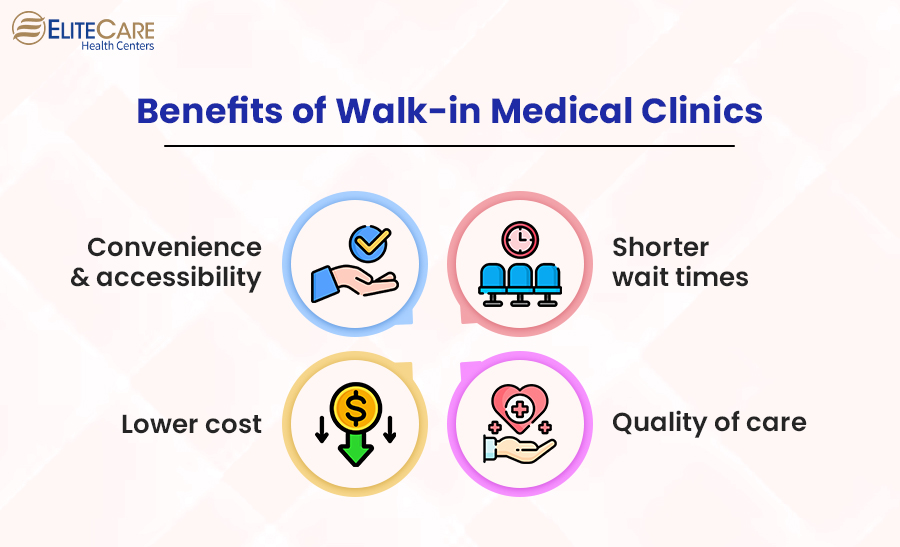
A walk-in medical clinic is a healthcare facility where patients can receive medical care without an appointment. These clinics are designed to provide efficient and convenient medical services for patients with non-life-threatening conditions, such as colds, flu, minor injuries, and infections. They are usually staffed by licensed healthcare providers, such as medical doctors, nurses, and physician assistants.
Patients can receive a wide range of medical services at medical walk-in clinics, including physical exams, lab tests, vaccinations, and prescription medications. Walk-in medical clinics are a convenient option for individuals who need medical attention but don’t have a regular doctor, or who can’t wait for an appointment with their primary care physicians.
How Does a Walk-in Clinic Work?
- Check-in: Patients will check in at the reception desk or kiosk and provide their personal and medical information.
- Triage: A medical professional will triage the patient to assess the nature and severity of their condition. It may involve taking vital signs, such as blood pressure and temperature, and asking the patient about their symptoms.
- Examination: After the triage, a healthcare provider, such as a medical doctor, nurse practitioner, or physician assistant will examine the patient.
- The healthcare provider will ask about the patient’s medical history, conduct a physical examination, and may order diagnostic tests, such as blood work or X-rays.
- Diagnosis and treatment: Based on the examination and diagnostic tests, the healthcare provider will make a diagnosis and recommend a treatment plan. It may include prescribing medications, providing medical advice, or referring the patient to a specialist or emergency department.
- Follow-up: The provider may ask the patient to follow up with their primary care physician or return to the walk-in clinic for additional treatment or monitoring.
Walk-in clinics do not have the infrastructure to attend life-threatening medical emergencies. For any serious medical concerns, seniors must visit the nearest hospital emergency department or call 911 immediately.
Benefits of Walk-in Medical Clinics

1. Convenience and accessibility
Walk-in clinics are becoming increasingly popular due to their convenience and accessibility, especially for minor illnesses or injuries. These clinics provide patients with easy access to medical care without the need for a prior appointment. This easy access can be particularly helpful for patients who don’t have a primary care physician or have limited access to medical care.
Besides, walk-in clinics often have extended hours and are open even on weekends. Therefore, this makes it more convenient for patients to seek medical attention outside regular office hours. Patients who work during the day or who have busy schedules can still receive medical care without taking time off work.
2. Shorter wait times
Walk-in clinics typically have shorter wait times compared to traditional doctor’s offices or emergency rooms. It is because walk-in clinics specialize in providing medical care for minor illnesses or injuries and do not typically handle emergencies or complicated medical cases. In the walk-in clinics, they have a streamlined process in which patients typically get appointments in the order they arrive.
3. Lower cost
Since patients visiting walk-in medical clinics do not need to schedule an appointment in advance, it helps in reducing the costs associated with scheduling and managing appointments. In addition, these types of medical clinics are not attached to hospitals, which means that patients don’t have to bear hospital fees for medical care.
4. Quality of care
Since walk-in clinics are comparatively a newer concept, there are misconceptions about the quality of care provided in these clinics. However, walk-in clinics have highly trained medical staff experienced in providing medical care for minor illnesses or injuries. These clinics adhere to standard medical protocols to ensure that patients receive safe and effective medical care.
Are Urgent Care Clinics and Walk-in Clinics the Same?
Urgent care clinics and walk-in clinics are similar in many ways, but there are some key differences.
Walk-in clinics are typically designed to provide quick and convenient medical care for minor illnesses and injuries, such as colds, flu, sore throats, and minor cuts and bruises. They offer a limited range of medical services and are usually staffed by a medical doctor, not a primary care physician. Walk-in clinics may also be located in retail settings, such as pharmacies or supermarkets, to make them more convenient for patients.
Urgent care clinics, on the other hand, are designed to provide more comprehensive medical care for a wider range of conditions, including more complicated illnesses and injuries that may require diagnostic tests or procedures. Urgent care clinics have primary care physicians and may offer a wider range of medical services, such as X-rays, lab tests, and prescription medications. They are also equipped to handle medical emergencies, although they cannot handle life-threatening emergencies, which should be treated in an emergency department.
Summing It Up
With the increasing demand for quick and convenient medical care, walk-in clinics have been growing extensively over the past few years. The convenience and accessibility of walk-in clinics have significantly improved healthcare access for underserved populations, including seniors and low-income communities.





